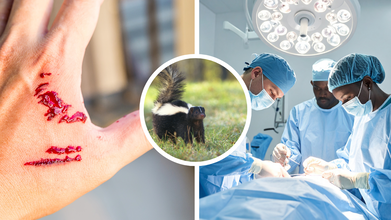- Health Conditions A-Z
- Health & Wellness
- Nutrition
- Fitness
- Health News
- Ayurveda
- Videos
- Medicine A-Z
- Parenting
Purple Doesn't Exist In Reality—It's How Our Brain Resolves A Visual Dilemma

Credit: Canva
Purple has been a dominant colour in our lives. Beyond those beautiful flowers, crayons, and candies, it is also often associated with royalty. Several kings and queens have been photographed wearing vibrant purple capes. As this colour continues to rule our environment, a new revelation about purple has left everyone shocked. Recently, scientists said that this colour does not exist in real life but is only a figment of our imagination.
Purple Has No Place In Electromagnetic Spectrum
Scientists have said that pruple doesn't exist, not in a way that we think. A new study has upended our perception of the colour wheel, revealing that purple is not a "real" colour in the spectral sense. Unlike red, orange, yellow, green, blue, and violet—which all correspond to specific wavelengths of light—purple has no unique place on the electromagnetic spectrum. Instead, it's a mental mashup, created by the brain to resolve a paradox it can't physically solve.
ALSO READ: Why Does RFK Want Whole Milk To Return To School
Here's What Actually Happens
When both red and blue wavelengths hit our eyes simultaneously—two ends of the visible light spectrum that should never naturally meet—the brain panics. Red and blue are like the North and South Poles of colour, never destined to blend in the linear sequence of light. simply bends the spectrum into a circle to make sense of the confusion. It fills in the gap by inventing a colour that doesn't technically exist in nature—voilà, we get purple. So purple is a colour that is technically not presen in the light spectrum, but exists as a solution to a problem.
Our Eyes Have Cone Cells For Colour Reception
To grasp why the illusion of purple occurs, we need to explore the biology of vision. Our eyes are equipped with three types of cone cells, each sensitive to short, medium, or long wavelengths—corresponding to blue, green, and red light, respectively. These cones transmit information to the brain through the optic nerve, where the thalamus and visual cortex analyse which cones were stimulated and to what extent.
This complex signalling system enables us to perceive not just basic colours but over a million distinct shades, including teal, magenta, and peach—each formed by combining inputs from various cones. However, purple disrupts this process. When both the short (blue/violet) and long (red) wavelength cones activate simultaneously without a corresponding spectral wavelength in between, the brain takes a creative leap. It invents a completely new colour. And this is how we get purple.
Purple Colour Has Psychological Effects
People often describe this colour as mysterious, spiritual, and imaginative. Meanwhile, psychologists associate the colour purple with the following aspects:
- Creativity
- Emotionality
- Enlightenment
- Femininity
- Imagination
- Inspiration
- Mystery
- Rarity
- Royalty
- Spirituality
ALSO READ: World Ovarian Cancer Day 2025: Theme, Significance, and History
Fact Check: Does Japan Have A Fat Law?

Credits: Canva
The internet is obsessing with the idea that Japan has a fat law, it fines people for being "fat". Talk about sensational headlines, mistranslations, and social media exaggerations. But what does Japan's so-called 'fat law' actually say? Does it really change anything?
Health and Me did a closer fact check on Japan's Fat Law, and here is what we found.
Japan's Metabo Law: What It Really Means?
In 2008, the Japanese Ministry of Health, Labour and Welfare introduced the Metabolic Syndrome Countermeasures Promotion Law, which was popularly nicknamed the 'Metabo Law'. the word 'metabo' comes from metabolic syndrome, a cluster of high-risk conditions that include elevated blood pressure, high blood sugar, abnormal cholesterol, and excess fat around the waist. If left untreated, this could increase the risk of heart attacks, stroke and diabetes.
The law's main focus is on identifying these risks as early as possible. As part of Japan's long-standing annual health check tradition, about 50 to 56 million adults aged 40 to 74 undergo this mandatory waist measurements every year. The waistline thresholds are:
- 85cm for men
- 90cm for women
While the numbers are not arbitrary, they match the International Diabetes Federation's guidelines used to screen metabolic risks.
Is It Illegal To Be Overweight In Japan?
The Times-Union fact check confirms: "Japanese citizens cannot be fined or imprisoned for being overweight". RosePlus Japan also reports that the term "fat tax is a mistranslation and that "it is not illegal to be fat in Japan".
The law does not:
- Fine individuals for their weight
- Send people to jail for being overweight
- Deport or deny visas based on size
- Ban obese people
How Does The Law Actually Work?
The law basically shifts the responsibility away from individuals to governments and employers.
Annual measurement: Employers and local authorities measure the waistlines of eligible adults.
If someone exceeds the limit:
- They are offered counseling, health guidance, and follow-ups.
- After three months, progress is reviewed.
- After six months, they may receive additional health education.
No individual penalties: There is no fine for not losing weight.
Employer penalties:
- If a company fails to reduce the percentage of employees at risk, it may face increased contributions to national healthcare funds.
- Companies like NEC previously estimated potential fines of up to $19 million for not meeting targets
This structure makes the Metabo Law more of a workplace wellness mandate than a personal weight regulation.
Lost In Translation
Much of the misunderstanding comes from how Japanese concepts were translated in English. With the word "law" being reported internationally, it implied a strict legal prohibition.
"Metabo" was incorrectly equated was being "fat", losing its medical meaning.
Was The Law Successful?
- Japan already had one of the lowest obesity rates in the world, around 3.5 percent in 2009, compared to over 30 percent in many Western countries.
- Life expectancy in Japan has remained among the highest globally.
- However, obesity rates among men (based on BMI 25+) reportedly continued rising, reaching 31.7 percent in 2022 according to The Japan Times, as cited in the HR Digest analysis
However, there have been things that changed since 2008. This includes companies offering nutrition workshops, physical activity support, health check programs for employees and their families. The annual health checks are now more structured. People flagged for metabolic syndrome were connected with counselling and monitoring, which can reduce long-term medical costs. The conversation has now also shifted towards body autonomy, public health and role of employers in personal wellness.
Diagnostic Anomaly: In An 'Exceptionally Rare' Case, Man Dies Of Rabies After Kidney Transplant

Credits: Canva
In a what doctors call an "exceptionally rare event', a Michigan man has died of rabies after receiving a kidney from a donor who was unknowingly infected with the virus. A recent report from the Centers for Disease Control and Prevention (CDC) gives information on how this rare medical event took place, with a surprising chain of exposures that vegan with a skunk scratch.
A Routine Kidney Transplant That Took a Sudden Turn
The Michigan patient underwent a kidney transplant at an Ohio hospital in December 2024. For several weeks, he seemed to be recovering normally. About five weeks after the procedure, he suddenly developed worrying symptoms such as tremors, weakness in his lower limbs, confusion and urinary incontinence. His condition deteriorated quickly and he was admitted to the hospital, soon requiring ventilation. Despite treatment, he passed away. Postmortem tests confirmed that he had rabies, a diagnosis that shocked doctors since his family said he had not been around any animals.
The Donor’s Skunk Encounter Comes to Light
The unexpected diagnosis pushed doctors to take another look at the kidney donor, a man from Idaho. In the Donor Risk Assessment Interview, he had mentioned that a skunk had scratched him. At the time, this detail did not raise major concern. When investigators spoke to the donor’s family again, they learned more about the incident. A couple of months before his death, the donor had been holding a kitten in a shed on his rural property when a skunk approached and behaved aggressively. He stepped in to protect the kitten and managed to knock the skunk unconscious. Before that happened, the animal scratched his shin deeply enough to draw blood. He believed he had not been bitten, and the incident was never viewed as a medical emergency.
The Donor’s Rapid Decline
Around five weeks after the skunk encounter, the donor began showing symptoms that closely resemble rabies. He became confused and had trouble swallowing and walking. His family said he experienced hallucinations and complained of a stiff neck. Two days later, he was found unresponsive at home after what was believed to be a cardiac arrest. He was resuscitated and hospitalized but never regained consciousness. He was declared brain dead after several days, and his organs, including his left kidney, were donated.
What Investigators Found
Once rabies was detected in the kidney recipient, authorities examined stored laboratory samples from the donor. These tests were initially negative. However, kidney biopsy samples revealed a strain that matched silver-haired bat rabies. This finding suggested that the donor had in fact died of rabies and unknowingly passed the virus to the transplant recipient.
Investigators believe a likely three step transmission occurred. A bat infected a skunk, the skunk infected the donor, and the donor’s kidney infected the recipient. The CDC noted that only three other cases of rabies transmission through organ transplantation have been reported in the United States since 1978.
Steps Taken to Protect Other Recipients
Three other people had received cornea grafts from the same donor. Once the risk was identified, the grafts were removed and all three individuals received Post Exposure Prophylaxis. They remained healthy and showed no symptoms.
A Reminder of Rare but Real Risks
Rabies is not routinely tested for in organ donors because human cases are extremely rare and difficult to diagnose. In this situation, the donor’s earlier symptoms were attributed to existing health conditions. Speaking to the New York Times, Dr Lara Danziger-Isakov said the case was exceptionally rare and reminded the public that the overall risk to transplant recipients remains very small.
China Reversed Its Air Pollution Problems; What Lessons Can Delhi Learn?

Credits: Canva
Delhi continues to wake up to thick haze on Wednesday morning, with 28 stations in 'poor' category, while nine stations remained under 'very poor'. Though there is a slight improvement as the average AQI stood at 269, in poor category. The Chief Minister of Delhi has enforced stricter measures like imposing fines up to Rs. 5,000 for open burning, and use of coal and firewood.
Delhi pollution has now affected people way beyond their respiratory health, it has now attacked almost all organs of their body, including fetus, reproductive health, liver, kidneys, and even chronic diseases like diabetes, obesity, blood pressure, and even mental health illness.
But could Delhi do more? Right now all the measures, including emergency measures like GRAP have not worked more than a dent. However, China seems to have reverse its pollution problem.
What Did China Do That Delhi Too Can Adopt?
In 2013, Beijing was battling with pollution problem. As per the data by the World Health Organization (WHO), in 2013, the annual means of PM2.5 levels reached 64.9 micrograms per cubic meter, whereas, in India, it was at 58.2. However, by 2019, China was able to bring it down to 38.15 micrograms per cubic meter while India remained at 50.17.
So, what did China do?
Since 2013, almost 80% of China has experienced air quality improvement. Beijing declared a war on pollution by shutting 3,000 coal boilers, which slashed coal use by 30%. It also forced factory to either close or comply with the guidelines. Clean energy also replaced soot and electric buses replaced diesel ones. The subway was expanded to 1,000 kilometers and by 2020, 40% of new cars were electric.
Chin's 11th Five Year Plan That Made Pollution A Priority
In the late 2000s, China began taking air pollution more seriously than ever. As per the UCLA Law professor Alex L Wang, China's 11th FYP (2006-10) made pollution a priority and used the "cadre evaluation system". This pushed officials to meet environmental targets. The system evaluates governors, mayors, and local leaders based on how well they perform compared to others in tackling pollution problem, which influences their promotions.
To cut pollution, China invested heavily in cleaner technology and shut down old, highly polluting factories such as power plants, smelters, and chemical units. The government also encouraged the shift to electric vehicles. Even though much of China’s electricity comes from coal, EVs still produce fewer emissions overall and create no tailpipe pollution in cities.
By 2017, Shenzhen became the first city in the world to fully electrify its 16,000 buses. Shanghai too followed its lead.
Studies by Tsinghua University and the Beijing Environmental Bureau showed that between 2013 and 2017, major improvements in air quality came from reducing coal boiler use, cleaner home heating, shutting down polluting industries, and controlling vehicle emissions.
The result was nothing less than remarkable. From 2013 to 2017, Beijing’s PM2.5 levels dropped by 35%, and life expectancy rose by 4.6 years.
© 2024 Bennett, Coleman & Company Limited

